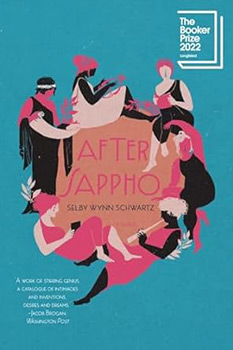Summary | Excerpt | Reviews | Beyond the book | Read-Alikes | Genres & Themes | Author Bio

A Novel
by Selby Wynn Schwartz
"Someone will remember us, I say, even in another time."
—Sappho, fragment 147
"Who was Sappho?" asks Selby Wynn Schwartz in the prologue to After Sappho. An ancient Greek lyric poet whose work survives only in fragments, most of Sappho's life has been the subject of fanciful speculation. We know she was from Lesbos; we know she was exiled to Sicily; we know that she had an island and was, as the prologue says, "garlanded with girls." Much of her work has been lost, but Sappho herself survives in collective memory as an extraordinary woman and artist who blazed her own trail and became legend.
For the women in this novel, and for the narrators who chronicle and comment upon the unfolding events like a Greek chorus, Sappho is the flame that kindles their creativity, the beacon that guides them, igniting their love and passion, turning their eyes toward the sea, and lighting the way into new, uncharted waters. The "we" used by the chorus of narrators becomes the "we" of all women who break new ground, transgress societal boundaries, love other women, and emulate Sappho by leaving lasting artistic legacies of their own.
In her debut novel, Schwartz presents a lavish, vibrant, kaleidoscopic re-imagining of the lives of early twentieth-century Sapphic feminists. With a narrative structure echoing the fragmentation of Sappho's surviving poems, their stories are set against a world that was changing rapidly but remained intransigent when it came to women's rights. The novel initially focuses on two Italian feminist writers: Sibilla Aleramo and Lina Poletti. Through their stories, readers witness the slow, painful process of recognizing women's legal equality. The narrative follows Aleramo as she is given in marriage to her rapist at only sixteen, an action that is legally sanctioned, later leaving her abusive husband and losing the right to see her child. The book is peppered throughout with information on feminists' legal and political battles, contextualizing obstacles women faced when attempting to lead their own lives and follow in Sappho's footsteps.
The primary focus, however, is on the women themselves, as the story moves from Italy across Sappho's Mediterranean to encompass other key female figures in the art, literature, and politics of the time. These include Ukrainian-Italian activist Anna Kuliscioff, American writer and literary salon hostess Natalie Barney, English poet Radclyffe Hall, American painter Romaine Brooks, actresses Eleonora Duse and Sarah Bernhardt, dancers Isadora Duncan and Ida Rubenstein, and writers Virginia Woolf and Vita Sackville-West. This dazzling array of women free themselves from their constraints and establish their own artistic communities. Blending history and fiction in a lush, sensual style reminiscent of lyric poetry, the novel follows each woman carving out a new life for herself and taking up Sappho's legacy to create art and blaze trails for future generations.
After Sappho often moves among these women's stories in nonlinear style, piecing together a patchwork pattern of intertwined lives and relationships. With such a wide scope, the novel's episodic nature occasionally seems almost too fragmented and even hurried; at times, readers might wish they could stay a bit longer with each woman and explore her life in more depth.
Nonetheless, Sappho's work permeates the stories with incisive and relevant excerpts from her poems, creating evocative snapshots of lives that jointly contributed to a flowering of female creativity. Toward the latter part of the book, in contrast to Sappho's idealism, the prophetess Cassandra becomes more prominent. With war and fascism on the horizon, her ominous portents highlight the fragile foundation upon which women's rights rested a century ago and can also be seen as foreshadowing the world today. In an era in which feminism's gains appear to be on shaky ground, this book reminds us of women's interconnectedness across generations, and how those who came before can inspire us to keep going, keep fighting, and keep creating.
![]() This review was originally published in The BookBrowse Review in January 2023, and has been updated for the
January 2024 edition.
Click here to go to this issue.
This review was originally published in The BookBrowse Review in January 2023, and has been updated for the
January 2024 edition.
Click here to go to this issue.

If you liked After Sappho, try these:

by M.T. Anderson
Published 2024
From the award-winning and bestselling author of Feed comes a raucous and slyly funny adult fiction debut, about the quest to steal the mystical bones of a long-dead saint

by Allen Bratton
Published 2024
Crackling with intelligence and wit, Henry Henry is a brilliant recasting of the Henriad in which Hal Lancaster is a queer protagonist for a new era.
Your guide toexceptional books
BookBrowse seeks out and recommends the best in contemporary fiction and nonfiction—books that not only engage and entertain but also deepen our understanding of ourselves and the world around us.